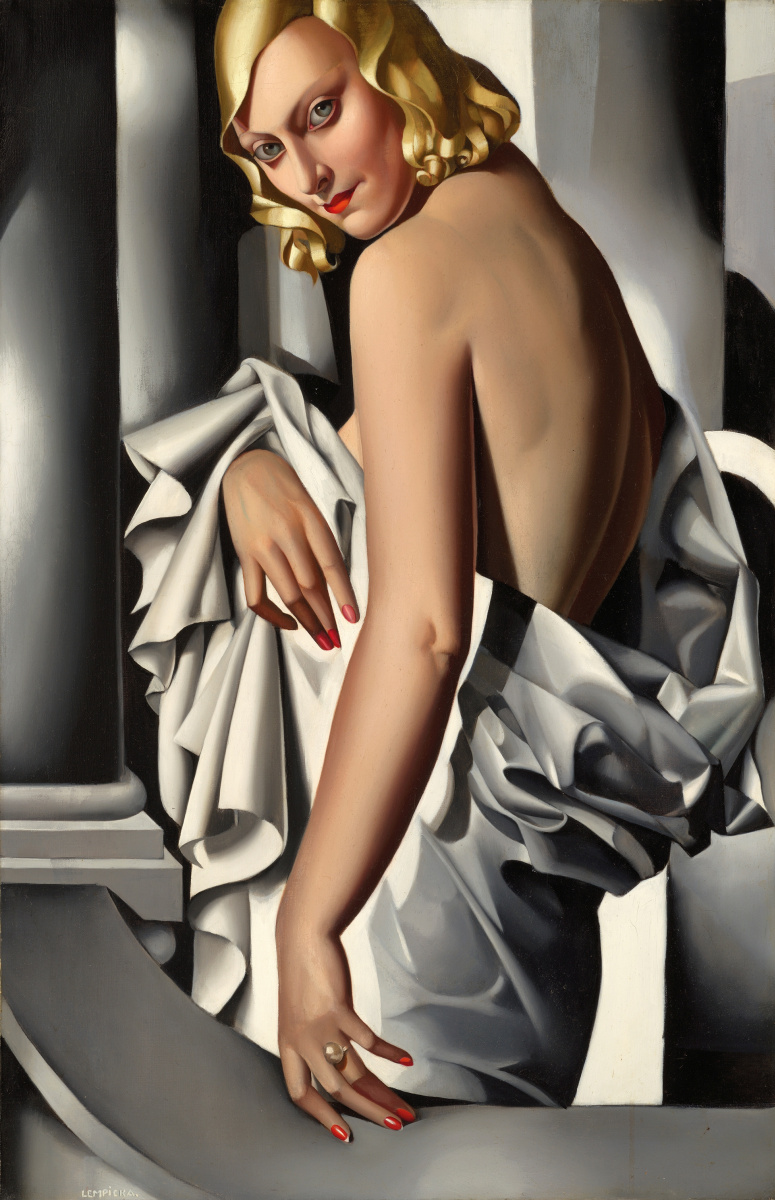Портрет Марджори Ферри
Описание картины «Портрет Марджори Ферри»
Молодая женщина, которая прогуливается по мраморному балкону, выглядит соблазнительно, но при этом целомудренно завёрнута в атласную простыню. Она могла бы быть актрисой, сделавшей головокружительный дебют в золотой век Голливуда – начинающей богиней-блондинкой, бросившей вызов Грете Гарбо, Джин Харлоу или Кэрол Ломбард. Марджори Ферри и вправду была артисткой, привыкшей к свету рампы, а именно – британской певицей кабаре, выступавшей в Париже. Повстречав богатого финансиста, она стала его женой. Новобрачный подарил ей кольцо с ярким крупным кабошоном и возможность увековечить драгоценность на портрете, который он заказал в 1932 году у самого модного и востребованного из парижских портретистов того времени – Тамары де Лемпицкой. Всего за несколько лет до того польская художница, известная своими чувственными ню, стала самой заметной женщиной среди ведущих живописцев-модернистов.
Лемпицка, прославившаяся как светская львица, в начале 1930-х годов находилась на пике славы. Профессиональные и социальные аспекты её жизни были неразрывно связаны друг с другом, а центром притяжения стала специально обустроенная в стиле ар-деко студия на рю Мешен, 7 в 14-м округе Парижа. Она вела собственный независимый образ жизни, который тогда был относительно редким достижением для женщины.
После короткой поездки в Нью-Йорк в конце 1929-го – начале 1930 года Лемпицка стала первым портретистом, востребованным как среди состоятельных европейцев, так и среди американцев, следивших за модернизмом, доминирующем в международном послевоенном искусстве. Она могла принимать заказы или отказываться от них, когда считала нужным. Интернациональный круг клиентов Лемпицкой был шире, чем у её главного конкурента Кеса ван Донгена. Хотя у того был более пылкий и безрассудный подход к работе, ему не хватало американских связей.
С конца 1920-х годов Лемпицка писала в своём фирменном высоком классическом стиле, который проявляется во всех аспектах этого смело задуманного «Портрета Марджори Ферри». Обстановка на нём, скорее всего, воображаемая, как если бы это были декорации к фильму о Древней Греции. В концепции Лемпицки полированная изогнутая каменная балюстрада и четыре восходящие колонны подхватывают её модель и возносят на высоту Олимпа, откуда Марджори Ферри взирает на мир. Решение художницы обрезать макушку натурщицы – кинематографический ход, но смелый и нечастый приём в портретной живописи; таким образом зритель воспринимает женщину более высокой. Тщательность, с которой Лемпицка выполнила драпировку, также является прямой отсылкой к древнегреческой классике.
Комбинируя стилистические черты французского кубизма, послевоенного пуризма и неоклассицизма со своими исследованиями ранних итальянских мастеров и демонстрируя понимание современных реалистических тенденций в Германии, Лемпицка создала собственный смело космополитичный и классический стиль. Она черпала вдохновение у Энгра, чей образцовый классицизм середины XIX века побудил Пикассо вернуться к фигуративной живописи после Первой мировой войны.
Лемпицка написала Марджори Ферри на переломном этапе своей карьеры, на фоне событий, произошедших тремя годами ранее. В октябре 1929 года, через девять дней после её прибытия в Нью-Йорк, рухнул фондовый рынок Уолл-стрит. Разорился и закрылся банк, куда художница внесла значительную сумму. Спасли её заказы, которые Лемпицки получала, благодаря своей деловой хватке (она утверждала, что к 28-ми годам стала миллионером) – художница умела «приземляться на ноги» в ситуациях, которые могли быть губительными для её коллег.
Парижский арт-рынок во многом держался за счёт богатых американских туристов и временно живущих во Франции граждан США. По мере развития кризиса они начали возвращаться домой. Дилеры перестали покупать, снизили цены и заменили персональные выставки групповыми. Пострадали даже ведущие художники – только Пикассо, самый известный и самый богатый из них, доверил своё значительное состояние разумному банкиру и с комфортом пережил финансовый хаос.
По общему мнению, 1932 год стал исключительным для карьеры Лемпицки. По мере углубления депрессии она фактически получала выгоду от тех, кто потерял больше всего денег, но хотел показать, что не боится экономических потрясений. Возможно протекцию Тамаре в написании «Портрета Марджори Ферри» оказала Сьюзи Солидор – новая любовница художницы и также певица из клуба. Автор включила эту работу в персональную выставку, которую открыла 10 мая в своей студии на улице Мешен, а через две недели отправила её в Салон Тюильри. В октябре того же года полотно было представлено в Galerie Fauvety на групповом показе, включавшем работы Пикассо.
В 2020 году «Портрет Марджори Ферри» стал самым дорогим произведением в творчестве Тамары де Лемпицки. На аукционе Christie’s 5 февраля он был продан за 16,3 миллиона фунтов стерлингов (21,2 миллиона долларов США).
Автор: Влад Маслов
Читайте в Артхиве: Тамара де Лемпицка: баронесса с кисточкой


